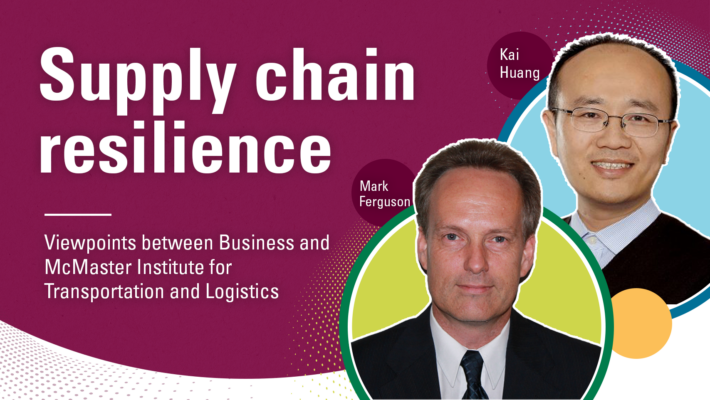Two experts weigh in on trust, resilience, and the future of supply chains
Contributed by Rebecca Hull, Marketing and Communications Strategist

The same experts who promoted the virtues of lean inventories (e.g. “just in time” manufacturing) now evangelize about supply chain resilience — the buzzword of the moment. How do organizations develop a stronger supply chain for the future?
 Kai Huang
Kai Huang
Associate Professor, Operations Management, DeGroote School of Business
The supply chain, the complicated network of different entities to provide product or service, often has three flows in it: material, money, and information. As a result, there are a lot of trends in supply chain management.
The use of big data to make better decisions
There are different forms of data existing in the supply chain. For example, data comes in the form of market research, demographic/behavioral databases, and more recently, in social media and search. This information is known as demand data, which specializes in integrating external data into your business processes. For example, Canadian Tire has more than 70,000 items in a store and has more than 1,700 stores nationwide. Canadian Tire could use this data to organize and stock their store to appeal to their existing customer base. Can this demand data be used to forecast future demand better and adjust the inventory replenishment? The answer is yes, and this involves multiple techniques under the same umbrella of “big data.” Using big data in retail supply chains is instrumental in predicting trends and ensuring stock is in the right place.
The use of blockchain to enhance trust in supply chains
Trust is important in supply chain management. For instance, suppose a company would like to buy a product. First, the company needs to evaluate and select suppliers. Second, to finish this transaction, the company may require a bank as an intermediary. These procedures can be lengthy and costly. Therefore, they can be called “the price of trust.” But if the company was to use blockchain technology, it could act as a decentralized mechanism to manage data. One of the most significant benefits of blockchain is that it can reduce the number of intermediaries in a supply chain significantly and thus reduce “the price of trust.”
Resilient supply chains
Before COVID-19, people relied on an efficient supply chain. If all the suppliers can provide qualified products, then we should select the supplier that offers the minimum cost. However, when there is a disruption of the supply chain, this practice can be problematic. COVID-19 showed that it is essential to build a supply chain resilient to supply chain disruption without a considerable increase in investment. Businesses should use multiple suppliers to reduce the risk of supply chain disruption.
Mark Ferguson
Senior Research Associate, McMaster Institute for Transportation and Logistics
Estimates suggest that global exports have expanded more than 40-fold in the past century (controlling for inflation). Just-in time production emerged as a marvel of almost symphonic co-ordination between elaborate webs of organizations to make very complicated end products. But clearly, it has taken a pandemic to reveal some underlying tensions between extensive international sourcing, over great distances, and running lean and well-choreographed supply chains that still depend critically on thousands of human contributors, often working in close proximity.
The future of supply chains
So, given this, what will the future hold? First, there is a confluence of many emerging technologies that will work together to transform supply chains in ways that are truly hard to conceive at this point. The internet of things, artificial intelligence, big data analytics, robotics and automation, autonomous transport, and cloud computing will be central to what happens. Second, the decarbonization of supply chains will be paramount. Third, a country’s domestic infrastructure, in its physical and digital forms, will have a significant bearing on how well it can compete internationally. Fourth, improvements to the “modal balance” of goods movement may boost its redundancy and thus resiliency. Finally, the coordinating role of government, working with an array of partners in helping to improve the playing field for its supply chains, cannot be underestimated.
The pandemic, along with volatile geopolitics, may induce decision-making changes
Perhaps firms will domestically source that single input from far away that they now feel puts an unacceptable risk on their overall operation. They may study shortcomings of the past year and put better backup plans in place. Perhaps consumers will show more interest in fully sourced products and made in their own country, even if the price is higher. Well-informed, conscientious long-term decision-making and technological advances hold the key to the improved supply chains of tomorrow.

Comment Policy
We generally welcome discussion on our blog posts. However, we reserve the right to edit or delete comments in certain situations:
This site is moderated by the DeGroote Marketing and Communications team. If you have any questions please email Katie Almas.